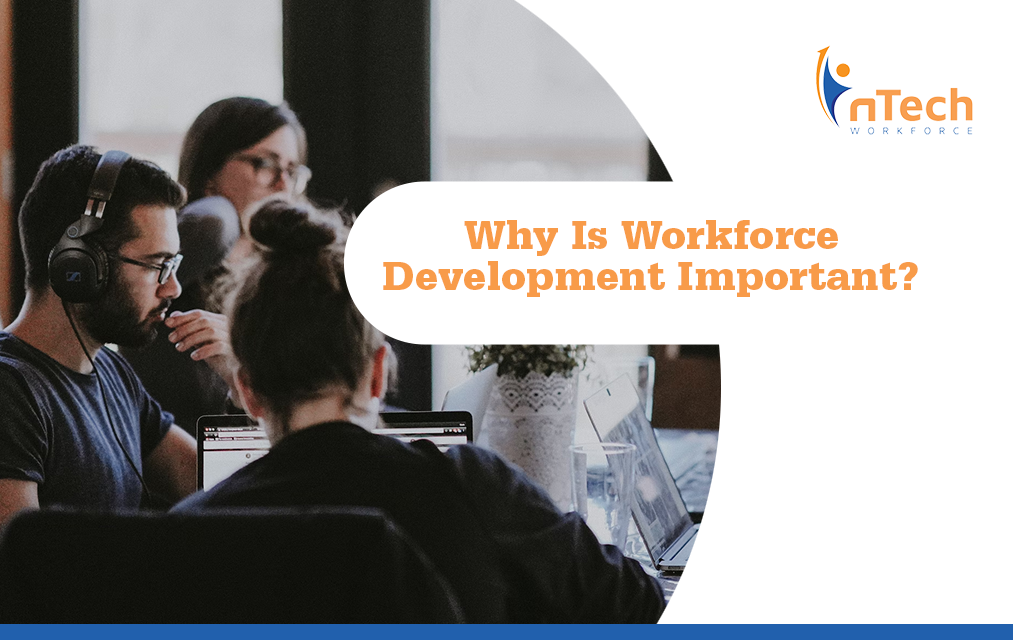Why Is Workforce Development Important?
Workforce development refers to all post-secondary education and training programs that expand the skills and capabilities of existing employees. The...
6 min read
![]() nTech Workforce
:
Sep 18, 2023 8:00:00 AM
nTech Workforce
:
Sep 18, 2023 8:00:00 AM

The modern workplace has evolved, giving rise to a more flexible and dynamic workforce. The contingent workforce, comprising temporary workers, freelancers, consultants, and other non-permanent employees, plays a vital role in today's organizational structures.
In this edition of nSider, Arthur Ransier, Director of Business Strategy at nTech Workforce, shares how the management of this diverse workforce is crucial, especially in terms of legal compliance, cost-efficiency, and strategic alignment across different business functions.
A contingent workforce refers to professionals who are not permanently employed by a company but are hired on a temporary, project, or contractual basis. This includes freelancers, temporary contract workers, consultants, and part-time employees. Unlike traditional employment, where employees are part of a long-term, full-time agreement with robust benefits, contingent workers often don't receive as many benefits and have time-bound assignments.
The primary difference between a contingent workforce and traditional employment lies in the relationship and obligations between the employer and the employee. Traditional employees typically have a more stable connection with the company, including consistent work hours and expectations for ongoing employment. In contrast, Ransier says, “… contingent workers offer flexibility and specialization for specific projects or periods of need.” This distinction requires businesses to adopt different management practices and legal considerations for contingent workers, making their integration into the organizational structure a unique challenge.
Organizations seeking to effectively manage a contingent workforce often partner with staffing agencies or other third-party partners to streamline the process. Here's how they can do so with a focus on essential areas like communication, expectations, integration, tracking, and compliance:
Clear communication is the cornerstone of effective contingent workforce management. Organizations must work closely with staffing agencies to articulate specific needs, requirements, and expectations. Ransier adds, “Regular updates and transparent dialogue can foster a seamless collaboration, minimizing misunderstandings and aligning objectives.”
Setting clear expectations is vital for a successful partnership. Defining roles, responsibilities, timelines, and deliverables ensures that all parties are aligned. Written agreements can further solidify these expectations, providing a reference point for performance evaluation.
Integration of systems between the organization, staffing agencies, and contingent workers enables a cohesive workflow. Whether it's sharing access to specific tools, implementing standardized software, or aligning data management protocols, systems integration can significantly enhance efficiency and collaboration.
Monitoring and tracking the performance of contingent workers are crucial for maintaining quality and accountability. Collaborative tracking mechanisms, such as regular check-ins and performance dashboards, can offer real-time insights. This proactive approach helps in making informed decisions, providing feedback, and ensuring alignment with organizational goals.
Why is Detailed Assignment Feedback Important to Staffing Partners?
Working with contingent workers requires careful adherence to legal and regulatory considerations. Collaboration with third-party partners must include defined compliance procedures, clear contractual agreements, and adherence to relevant employment laws. Regular audits and reviews, preferably conducted in partnership with legal experts, safeguard against potential liabilities and ensure that both the organization and its third-party partners operate within the legal framework.
Managing a contingent workforce through partnerships with staffing agencies or third-party entities requires a strategic approach, focusing on communication, expectation-setting, systems integration, performance tracking, and legal compliance. By prioritizing these elements, organizations can create a synergistic relationship that maximizes the value of the contingent workforce while minimizing risks.
Compliance must be at the forefront of managing contingent labor. Hiring contingent workers brings several specific considerations that organizations must address. Some of these include:
Are Threats of Worker Misclassification Ignored, while Managing Co-Employment Risk?
The legal and compliance landscape for hiring contingent workers is complex and multifaceted, encompassing areas like labor & tax laws, joint employment & worker misclassification, cost overrun, and intellectual property concerns. Organizations should engage legal and compliance experts, define clear contracts, and establish transparent processes. By adopting a proactive and informed approach, they can effectively navigate these challenges, ensuring a productive and legally compliant contingent workforce management strategy.
Technology and software solutions are vital in managing contingent labor effectively. In particular, Vendor Management System (VMS) technology is at the center of contingent workforce management and plays a pivotal role, offering features that streamline processes and increase efficiency.
Through integrations with HRIS and other systems, a VMS creates seamless data flows; ensuring integration between these platforms can facilitate information sharing, improve decision-making, and enhance overall workforce management. Similarly, a VMS can be configured or customized to match your unique requirements, aligning with specific needs, preferred processes, industry standards, and regulatory compliance. Select VMS providers provide information on the go with mobile solutions; some VMS platforms offer mobile access, allowing managers and contingent workers to interact, update, and monitor progress anytime, anywhere.
The right technology will offer an abundance of automation, eliminating manual processes that can be time-consuming or tedious. You should embrace a VMS solution that offers automation for tasks such as onboarding, timesheet approval, and invoicing, thereby saving time and reducing errors. Consolidated invoicing, for example, is a standard feature of a VMS that allows you to manage multiple invoices in one plate, simplifying the billing process, enhancing financial tracking, and improving audibility. Protecting sensitive information is paramount; don’t forget that the VMS platform should comply with the latest security standards to safeguard data integrity and confidentiality.
What are the best vendor management systems in staffing?
Utilizing VMS technology with robust reporting and analytics capabilities offers real-time insights for tracking performance and making data-driven decisions. While your contingent labor needs may fluctuate over time, VMS technology is scalable and can adapt to changing needs, ensuring that the system remains efficient regardless of the size of the contingent workforce. All these insights into the contingent workforce performance are crucial.
Still, the success of the VMS depends on user engagement. Choosing a user-friendly VMS solution and providing training to encourage user adoption ensures that your business teams, operations teams, staffing partners, and other stakeholders can utilize the system effectively.
Vendor Management System (VMS) technology offers a powerful tool to manage contingent labor, with functionalities like integrations, scalability, customization, mobile access, reporting, automation, invoicing, security, and user adoption. By strategically employing this technology, organizations can greatly enhance their ability to manage contingent labor efficiently and effectively, aligning with their unique needs and industry best practices.
The area of contingent workforce management is constantly evolving, and several trends and future developments are expected to shape this landscape:
According to Ransier, “Contingent workforce management is at the cusp of significant transformation, driven by technological innovation, changing workforce dynamics, regulatory shifts, and evolving business priorities. Embracing these trends and being prepared for future developments will be crucial for organizations to leverage the benefits of contingent labor effectively. The focus will increasingly be on creating a holistic workforce strategy that includes contingent workers, recognizing their vital role in organizational agility and success.”
The contingent workforce is a complex yet invaluable part of today's business environment. Managing it effectively requires careful planning, understanding of legal obligations, leveraging technology, and focusing on integration and quality control. Partner with nTech Workforce to embrace the benefits, mitigate challenges or risks, and foster strategic alignment with procurement, finance, human resources, and contingent workforce operations teams.

Workforce development refers to all post-secondary education and training programs that expand the skills and capabilities of existing employees. The...

In this edition of nSider, Arthur Ransier, Director of Business Strategy at nTech Workforce, sheds light on the intricacies of collaborating with a ...